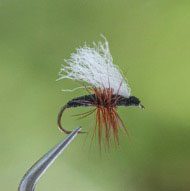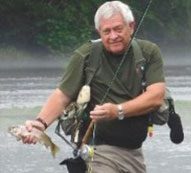
www.rockyrivertu.org/dry-fly-patterns.html
There are times when fly patterns that are intended to imitate floating aquatic insects such as mayflies, caddisflies, and stoneflies simply fail to attract a topwater strike from trout. Maybe they are keyed on feeding in the water column or on the bottom. These conditions are very similar to the ‘dog days’ of summer when there is little or no aquat-ic insect activity on streams. In either case, a good ant fly patterns seems to be a recipe for success.
Dale and Jerry Hodge, who were close friends and angling buddies of Don and Dwight Howell, designed an ant fly pattern that has been highly effective on Southern Appalachian streams.
Do not let the name mislead you. Don Howell named the fly pattern because the initial, highly productive fly pattern they used on Hazel Creek was a size 10 or “big” like eve-rything touted from Texas.
“Due to the overgrown size, brown hackle and white wings, the fly is not impressive, as ant fly patterns go. But because dad (Don Howell) was so impressed with the fly, we (Dwight Howell and Kevin Howell) decided to tie a few and try them out. It truly does catch trout when other traditional fly patterns fail.” – Kevin Howell
When trout are more-selective or refuse conventional fly patterns, even smaller ver-sions of this fly pattern are usually productive. Who knows? A trout may see the silhou-ette of a caddisfly due to the dark body and wing.
The position of the poly yarn wing traps air and the oversized, trimmed hackle both make this fly pattern a super floater. The white wing also provides a hi-vis element to the fly pattern making the prominently visible in the water, an advantage not typical of ant fly patterns.
Note: Don Howell was Kevin Howell’s father. Dwight Howell was Kevin Howell’s un-cle. Don and Dwight were brothers that founded the Davidson River Outfitters. Kevin Howell is now the owner. This fly pattern is from the book Tying & Fishing Southern Appalachian Trout Flies written by Don Howell with contributions from Kevin Howell and published in 1999 by Davidson River Outfitters (DRO).
Originated by Dale & Jerry Hodge for Hazel Creek. This terrestrial fly patter was promoted and sold by Don R. Howell from Brevard in his fly shop, Kevin Howell his son now owns and operates his fathers fly shop, Davidson River Outfitters.
Texas Piss Ant – Rocky River Fly of The Month 6.22
Hook: Tiemco 3679 heavy nymph or equivalent
Size: 12, 14, 16, 18
Thread: 8/0 Black Uni or equivalent
Body: Black fly rite poly dubbing or tying thread
Hackle: Oversized coachman brown hackle, trimmed
Wing: White poly yarn

Directions
Detailed tying steps may be found at the Rocky River Chapter of Trout Unlimited at www.rockyrivertu.org/dry-fly-patterns.html.
- Debarb and mount the hook adding thread just behind the hook eye.
- Wrap the thread in tight touching turns to the hook bend and slightly down the bend.
- Bring the thread forward to two eye lengths back from the eye. Repeat taking the thread toward the bend but stopping short and return to the thorax, stopping short. Do this three times and stop short each time. This will build a tapered thread body.
Alen D. Baker Choose a rooster hackle that is about one and one half the hook gape and strip a quarter inch of barbs from the base to use in tying in.
- Tie in the stripped stem with the shiny side toward the eye and at about the half way mark and then advance the thread to the thorax once secure.
- Advance the hackle in tight touching turns for about five wraps and bind in with the thread.
- Cut away the waste hackle and select a piece of poly yarn. Secure the poly yarn on top of the hook shank with several turns cover and trim any waste poly and form a small thread head. Whip finish and trim the waste thread. 8. Trim the poly yarn to the length of the hook shank before the bend.
